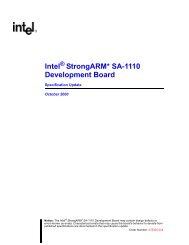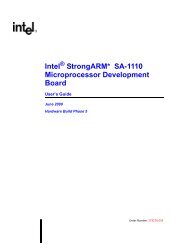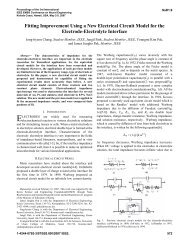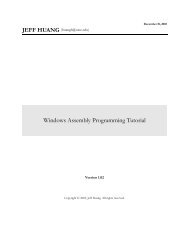Beej's Guide to Network Programming Using Internet Sockets
Beej's Guide to Network Programming Using Internet Sockets
Beej's Guide to Network Programming Using Internet Sockets
- No tags were found...
Create successful ePaper yourself
Turn your PDF publications into a flip-book with our unique Google optimized e-Paper software.
Beej’s <strong>Guide</strong> <strong>to</strong> <strong>Network</strong> <strong>Programming</strong> <strong>Using</strong> <strong>Internet</strong> <strong>Sockets</strong> 17Since datagram sockets aren’t connected <strong>to</strong> a remote host, guess which piece of informationwe need <strong>to</strong> give before we send a packet? That’s right! The destination address! Here’s the scoop:int send<strong>to</strong>(int sockfd, const void *msg, int len, unsigned int flags,const struct sockaddr *<strong>to</strong>, socklen_t <strong>to</strong>len);As you can see, this call is basically the same as the call <strong>to</strong> send() with the addition of twoother pieces of information. <strong>to</strong> is a pointer <strong>to</strong> a struct sockaddr (which you’ll probably have asa struct sockaddr_in and cast it at the last minute) which contains the destination IP addressand port. <strong>to</strong>len, an int deep-down, can simply be set <strong>to</strong> sizeof(struct sockaddr).Just like with send(), send<strong>to</strong>() returns the number of bytes actually sent (which, again,might be less than the number of bytes you <strong>to</strong>ld it <strong>to</strong> send!), or -1 on error.Equally similar are recv() and recvfrom(). The synopsis of recvfrom() is:int recvfrom(int sockfd, void *buf, int len, unsigned int flags,struct sockaddr *from, int *fromlen);Again, this is just like recv() with the addition of a couple fields. from is a pointer <strong>to</strong> alocal struct sockaddr that will be filled with the IP address and port of the originating machine.fromlen is a pointer <strong>to</strong> a local int that should be initialized <strong>to</strong> sizeof(struct sockaddr).When the function returns, fromlen will contain the length of the address actually s<strong>to</strong>red in from.recvfrom() returns the number of bytes received, or -1 on error (with errno set accordingly.)Remember, if you connect() a datagram socket, you can then simply use send() and recv()for all your transactions. The socket itself is still a datagram socket and the packets still use UDP,but the socket interface will au<strong>to</strong>matically add the destination and source information for you.4.8. close() and shutdown()–Get outta my face!Whew! You’ve been send()ing and recv()ing data all day long, and you’ve had it. You’reready <strong>to</strong> close the connection on your socket descrip<strong>to</strong>r. This is easy. You can just use the regularUnix file descrip<strong>to</strong>r close() function:close(sockfd);This will prevent any more reads and writes <strong>to</strong> the socket. Anyone attempting <strong>to</strong> read or writethe socket on the remote end will receive an error.Just in case you want a little more control over how the socket closes, you can use theshutdown() function. It allows you <strong>to</strong> cut off communication in a certain direction, or both ways(just like close() does.) Synopsis:int shutdown(int sockfd, int how);sockfd is the socket file descrip<strong>to</strong>r you want <strong>to</strong> shutdown, and how is one of the following:• 0 – Further receives are disallowed• 1 – Further sends are disallowed• 2 – Further sends and receives are disallowed (like close())












